#python datatype program
Text
Datatypes
Hello everyone! There is a new blog post on SimpleSyntax covering datatypes. You can find it here https://lnkd.in/gftC9sHz
Understanding these basic datatypes is crucial to programming. #programming#python#coding#datatypes#codingbootcamp
0 notes
Note
hi. i had a very similar experince to trying to look through the code camp scams and everything online and not living near anything useful. if you can find an online real college thats what i did, granted its a community college and an associates but. other than that, don't sleep on utilizing chatgpt to teach you. thats how i learn all of my material. you can ask it questions or say "can you teach me about x", and if you dont like its response you can say things like "make that more simple" or "make that interactive". but helpful tip, all programming languages basically do the same things and work in very, very similar ways. if you just learn the fundamentals of programming you can just translate that to any language. in my opinion, the basics to learn are: the structures of programming (sequential, conditional, iterative), variables, datatypes (integer, string, float, etc)(in python those are it), conditional statements(these are those if-else things you see), iterative aka loops(do..while, for x in list, do until, etc), functions(keep em one purpose), passing data. i would say these are the fundamentals. every language does it (besides html bc thats not a programming language but just a mark up language), so once you know about the conditonal structure for example, just find out "how do i use this in x language". if you are learning python now, its a great language to learn about programming and you've probably realized by now that people most often use it in an object oriented way, but you don't have to and don't have to learn about classes or objects if you don't have the fundamentals down yet. i hope this helps and if you have any questions feel free to ask me

Oh I 100% agree with this advice.
After looking for a long, long time, I realised the most legitimate courses were from 'real' colleges and education suppliers that offered 'brick n mortar' schooling as well as e-learning.
I'm definitely going to utilise the free resources online and then work towards building a profile and generally seeing what the jobs online look for and work towards that alongside the usual path of learning :)
Also, I love how supportive folk generally are in this area of learning. I knew it would be competitive, especially when it comes to getting a job in a year or so...but seeing folk lift each other up instead of put each other down is heart-warming on so many levels. It makes me think I've found my correct career path :)
#codeblr#supportive#thank you#advice#solid advice#good advice#lovely ask#thank you friend!#I love codeblr#programming#learning to code#learning programming#python#web development#coding
24 notes
·
View notes
Text
Re-Learning C# Studies #1 and #2


Tuesday 09 May 2023
Yes starting from the beginning again! I actually started yesterday night but forgot to post about it! So, this is a combined post! Yesterday I made my study plan (I used ChatGPT to make the plan since I'm lazy~) and I started with Day 1 and 2 which focuses on "Basic Syntax and Data Types"~!

Basic Syntax
Just learnt the complete basics of any programming language; it's syntax. I already know this. I am pretty confident in this. It's understanding things like the keywords such as using, namespace, class and static void!

Data Types
Another sub-topic I already know a lot in is the C# data types! In C# you have to declare the type the data will be before using it - unlike languages like JavaScript, Lua and Python where you can just declare and the program will automatically assign the datatype based on the value. Declaring data types in C# is beneficial because it provides more clarity and specificity in the code. I think it helps catch errors quicker as well~!


That's all I learnt in the last 2 days! Really happy I got to go over the basics again! Here are the resources that I used:
Codecademy - link
Software Testing Help - link
TutorialsTeacher - link
Thanks for reading and happy coding! 🥰👍🏾💗

#codeblr#coding#studyblr#studying#progblr#programming#comp sci#computer science#tech#code#learn to code#csharp#csharp study#dotnet
56 notes
·
View notes
Text
dreamdoll watchlist ★
youtube
key takeaways:
python is a good beginning coding language to start with
start with: variables, datatypes, loops, functions, if statements, oop
if you covered the basics, it would and should take you approx. 2 weeks.
first project: do something interesting/useful. start small.
simple games or a food recommendation system with specific ingredients
panda dataframe
use API = application programming interface = different pieces of software interacting with each other. grabbing data from another source
after your first project, learn about data structures and algorithms. how API works. learn how to read documentation.
dictionary
linkedlists
queues
heaps
trees
graphs
learn about more things and how to implement them into projects.
correct mindset:
implementation and application > theory and concepts
knowing ≠ being able to do it
stay curious.
explore things outside of what is prescribed in a resource. that's how you learn about different concepts and how you deeply understand the concepts that you already know.
the best programmers they've met are the tinkers. these are the people who play around with their code and try a bunch of different things.
getting stuck:
it all comes down to problem solving. be comfortable with not knowing things and staying calm while trying to figure out the problems
how to learn even faster:
find a community where you work on projects together. you will learn so many things from other experiences programmers just by interacting with them. and accountability because you just can't give up
learning is never ending. you will always be learning something new.
11 notes
·
View notes
Text
Best Data Science Courses in Mumbai

Data Science Courses in Mumbai
Begin your journey towards enhancing your Data Science career with our exclusive Data Science course in Mumbai. Our comprehensive Data Science training in Mumbai with placement assistance is designed to help you master Python, Tableau, Hadoop, and Spark. Furthermore, you'll have the opportunity to gain world-class training from industry leaders and master the most in-demand data science and machine learning skills.
Why Choose DeveLearn for Data Science Course in Mumbai?
📊 Comprehensive Curriculum: Dive deep into the world of data science with our cutting-edge curriculum, covering everything from Python programming to advanced machine learning.
👩🏫 Expert Instructors: Learn from seasoned data scientists who bring real-world insights to the classroom, ensuring you gain practical skills that matter in the industry.
💼 Career Assistance: Your success is our mission. We provide comprehensive data science training and job placement assistance to help you kickstart your data science career.
🤝 Network & Connect: Join a vibrant data science community in Mumbai. We host networking events, seminars, and workshops, putting you in touch with industry leaders.
🏆 Certification: Earn a prestigious certification upon completion, giving you a competitive edge in the job market.
Career Assistance: At our institute, we are dedicated to your success. We offer comprehensive both online & offline data science course in Mumbai with placement assistance to kickstart your data science career with confidence.
Data Science Course Curriculum
Python
A comprehensive program for beginners to become skilled developers, focusing on popular libraries like NumPy, Pandas, and Django, enabling practical data analysis and web development.
Introduction to Python
Basic Syntax, Operators
Datatypes
Conditional Statements
Loops
Functions and Recurrsion
Object Oriented Programming
File Handling
Exception Handling
Web Scrapping
Libraries
Database Connectivity
SQL
The SQL module equips beginners with fundamental skills for managing and querying relational databases, making it an excellent starting point for Data Science and Analyst jobs.
Introduction To Databases
Introduction To SQL
SQL Data Manipulation Language
SQL Data Definition Language
Filtering and Sorting Data
Grouping and Aggregating Data
Joining Tables
Subqueries
Set Operations
SQL Data Control Language
Transaction Control
SQL Triggers
SQL Views
Statistics & Machine Learning
Our top-tier center offers comprehensive statistics and machine learning courses, equipped with expert faculty, state-of-the-art facilities, and industry partnerships for real-world challenges.
Descriptive & Inferential Statistics
Probability Distribution
Confidence Interval
Hypothesis Testing
Machine Learning Introduction
Supervised & Unsupervised Machine Learning
Linear Regression & Logistic Regression
Decision Tree & Random forest
Bagging & Boosting
Clustering
Dimension reduction Technique
Recommendation Engine
Overfitting & Underfitting
Model Evaluation Techniques
Artificial Intelligence
The AI, Deep Learning, and NLP module takes your skills to the State of the Art, enabling you to program Deep Learning machines and NLP-like computers with expert guidance and easy-to-understand resources.
Introduction to Artificial Intelligence
Introduction to Deep Learning
Artificial Neural Network (ANN)
Convolution Neural Network (CNN)
Recurrent neural Network (RNN)
Long Short-Term Memory (LSTM)
Generative Adversarial Network (GAN)
Natural language Processing
Text Preprocessing
Named Entity Recognition
Sentiment Analysis
Text Summarisation
Data Science Course Certification
Demonstration of Skills and Knowledge
Our data science institute in Mumbai offers a comprehensive curriculum that covers cutting-edge tools and sought-after techniques such as Python, R-Programming, and more.
This course certification serves as a powerful credential, opening doors to a multitude of opportunities when strategically leveraged. Armed with proficiency in these skills, you'll be well-equipped to excel in your career in record time.
Industry Recognition and Credibility
Upon successful completion of the Masters Program in Data Science and Machine Learning course at our esteemed data science classes in Mumbai, you will receive a recognized Certification from DeveLearn.
This certification not only validates your expertise as a data professional but also jumpstarts your career or takes your existing one to new heights. It adds significant value to your professional profile and enhances your resume.
0 notes
Text

Python's Built-in Datatypes
Python, a versatile and powerful programming language, provides a range of built-in datatypes that make it easier to work with different types of data. In this blog post, we will explore the most commonly used datatypes in Python and learn how they can be utilized in your programs.
Datatypes can be categorized as either mutable or immutable. Understanding the difference between mutable and immutable types is crucial for writing efficient and bug-free code.
Mutable Types: Mutable types are those that can be modified after they are created. This means that you can change their values, add or remove elements, or modify their properties without creating a new instance of the datatype. Examples of mutable types include lists, sets, dictionaries, and bytearrays.
Immutable Types: Immutable types are those whose values cannot be changed once they are created. If you want to modify an immutable type, you need to create a new instance with the desired changes. Examples of immutable types include integers, floats, strings, tuples, and frozensets.
Why Does It Matter?
Understanding the mutability of datatypes is important because it affects how data is stored and manipulated in memory. Mutable types consume more memory because they allow for in-place modifications. On the other hand, immutable types are more memory-efficient because they require the creation of a new instance whenever changes are made.
Additionally, mutability affects how data is passed between functions. When a mutable object is passed as an argument to a function, any modifications made to the object within the function will be reflected outside the function as well. However, immutable objects are passed by value, meaning that any modifications made within a function will not affect the original object outside the function.
By understanding the mutability of different datatypes, you can write more efficient and bug-free code by choosing the appropriate datatype for your specific use case.
You can see a datatype of a variable by type(). It returns the specific datatype of the variable
Numbers:
Python supports various numeric datatypes, including integers (int), floating-point numbers (float), and complex numbers (complex). These datatypes allow you to perform arithmetic operations and handle mathematical calculations with ease.
x = 10
y = 3.14
z = complex(2, 3)
print(type(x)) # Output: <class 'int'>
print(type(y)) # Output: <class 'float'>
print(type(z)) # Output: <class 'complex'>
Strings:
Strings are used to represent text data in Python. They can be enclosed in single quotes (''), double quotes (""), or triple quotes (''' '''). Python provides a wide range of string manipulation methods, allowing you to concatenate, split, and modify strings.
name = "John"
greeting = "Hello, " + name + "!"
print(greeting) # Output: Hello, John!
Lists:
Lists are versatile and mutable collections of items in Python. They can store elements of different datatypes and are enclosed in square brackets ([]). Lists can be modified by adding, removing, or modifying elements.
fruits = ["apple", "banana", "orange"]
print(fruits) # Output: ['apple', 'orange', 'orange']
Tuples:
Tuples are similar to lists but are immutable, meaning their elements cannot be modified after creation. They are enclosed in parentheses (()) and can store different types of data. Tuples are commonly used to represent a collection of related values.
point = (5, 10)
print(point[0]) # Output: 5
print(point[1]) # Output: 10
Dictionaries:
Dictionaries are key-value pairs that allow you to store and retrieve data based on unique keys. They are enclosed in curly braces ({}) and provide efficient lookup operations. Dictionaries are useful for building data structures and organizing data.
student = {"name": "John", "age": 25, "grade": "A"} print(student["name"]) # Output: John
print(student["age"]) # Output: 25
Set:
Sets are unordered collections of unique elements in Python. They are enclosed in curly braces ({}) or can be created using the set() function. Sets allow you to perform operations like union, intersection, and difference, making them useful for tasks like removing duplicates from a list.
fruits = {"apple", "banana", "orange"}
print(fruits) # Output: {'apple', 'banana', 'orange'}
Frozenset:
Similar to sets, frozensets are immutable sets in Python. Once created, the elements of a frozenset cannot be modified. Frozensets are useful when you need a set-like object that can be used as a key in a dictionary.
colors = frozenset(["red", "green", "blue"])
print(colors) # Output: frozenset({'red', 'green', 'blue'})
8. Range:
The range datatype represents a sequence of numbers. It is commonly used in for loops to iterate over a specific range of values. The range() function takes start, stop, and step arguments to generate the desired sequence.
for i in range(1, 5):
print(i)
# Output: # 1 # 2 # 3 # 4
Pay attention to location of print statement. Here let me tell you very important thing. Indentation of code lines is VERY, VERY important in python. It crucial in determining the order of execution for code.
Indentation is used to define the structure and hierarchy of code blocks. Unlike other programming languages that use braces or keywords to denote code blocks, Python uses indentation to determine the scope of statements within loops, conditionals, functions, and classes.
Here are code structure and code execution aspects where indentation plays role:
Code Readability: Indentation improves code readability by visually representing the logical structure of the code. It makes it easier for developers to understand the flow and organization of the program. Proper indentation ensures that code is visually appealing and easier to comprehend, especially when working with complex projects.
Block Identification: Indentation helps Python identify the beginning and end of code blocks. It distinguishes between different levels of nesting within loops, conditionals, function definitions, and classes. By indenting code blocks consistently, it becomes clear which statements belong to a particular block and which ones are outside of it.
Syntax Requirement: In Python, correct indentation is a syntax requirement. If the code is not indented properly, Python will raise an "IndentationError" and the program will fail to execute. This strict enforcement of indentation ensures that code is well-structured and reduces the chances of introducing errors due to incorrect block placement.
Code Execution: Indentation affects the execution of code in Python. Statements that are indented at the same level are considered part of the same block and are executed together. The indentation level determines the scope and order in which statements are executed. Correct indentation ensures that code behaves as intended and produces the desired results.
Byte and Bytearray:
Byte and bytearray are datatypes used to represent sequences of bytes in Python. They are often used in scenarios where binary data needs to be processed or manipulated, such as reading and writing files in binary mode.
data = b'Hello'
data_array = bytearray(b'World')
print(data) # Output: b'Hello'
print(data_array) # Output: bytearray(b'World')
Memoryview:
The memoryview datatype in Python provides a memory-efficient way to access and manipulate the underlying data of an object. It allows you to view the data in different formats and perform operations directly on the memory without creating additional copies.

1 note
·
View note
Text
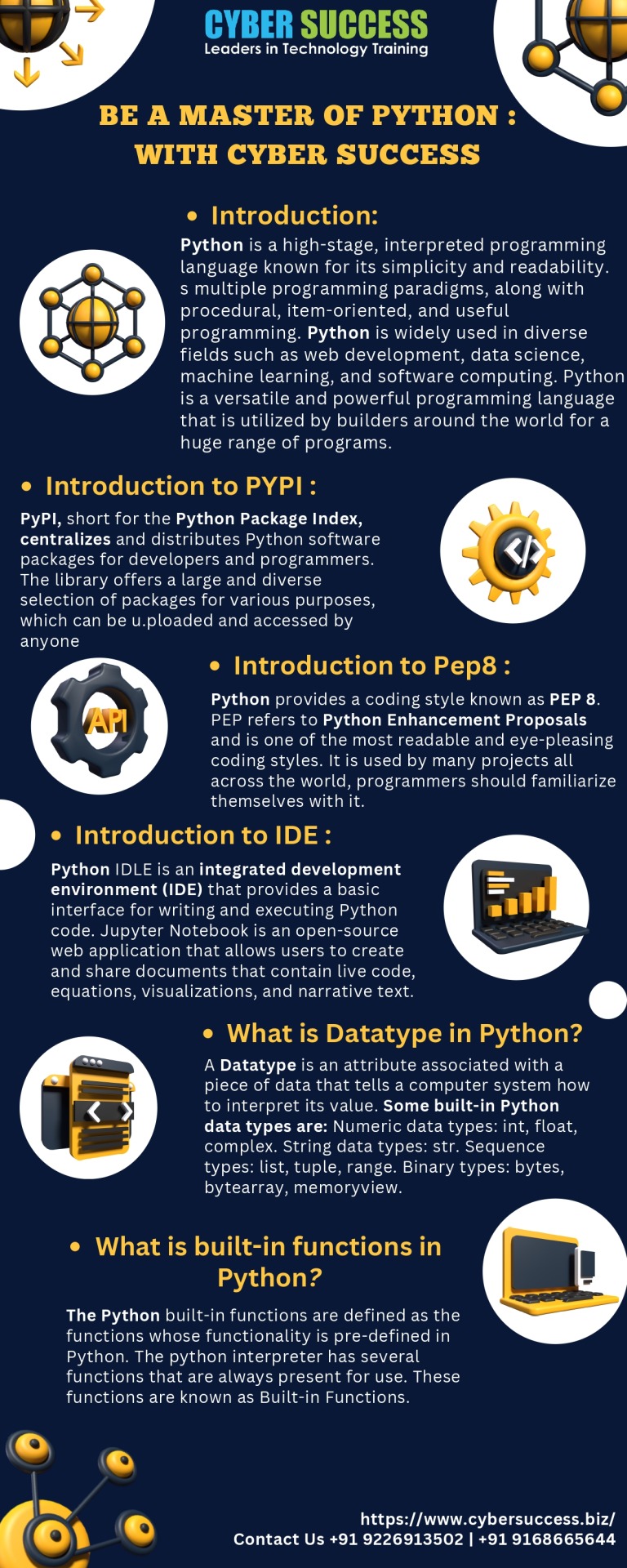
In today's technological world, Python is often used as a support language for software developers, for build control and management, testing, and in many other ways. Python is a high-level general programming language. It is an object-oriented programming language. Python is a high-stage, interpreted programming language known for its simplicity and readability.
In this infographic, you will learn the basic concepts of Python programming and also about some functions of Python like PYPI , Pep8, IDE, Datatype and more. At Cyber Success, whether you are an experienced software pro, new to coding, or just starting out in IT, our Python courses in Pune can open the door to exciting opportunities in this tech career in this case.
0 notes
Text
Python Unveiled: A Beginner's Odyssey into the World of Coding Magic
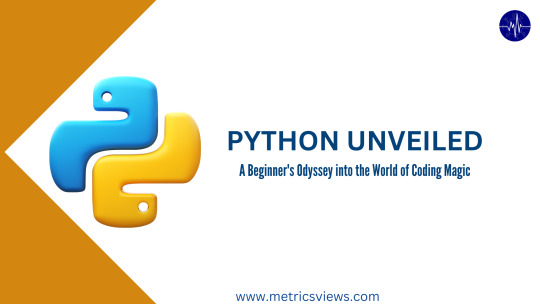
Installation:
Visit the official Python website: https://www.python.org/downloads/windows/
Click the appropriate link for your system to download the executable file: Windows installer (64-bit) or Windows installer (32-bit).
Run that downloaded executable installer file. For example, python.exe file.
Click Install to start the installation.
After the installation is complete, a Setup was successful message is displays.
To verify python installation:
Enter the code: python --version

Now you are ready to start learning and programming in Python.
Quick Summary:
Python has syntax that allows developers to write programs with less lines than some other programming languages. Python runs on an interpreter system. Python is a computer programming language often used to build websites and software, applications ,conduct data analysis.
Targeted Audience:
This article is intended for those people interested in learning the fundamentals of python development. It will be useful for freshers, backend developers, students. and for those who are lazy to write lengthy code because python has easy, simple syntax which includes short code.
Use Cases:
Web development -framework: Django, Flask, FastAPI, etc.
Data analysis - Pandas, NumPy
Game development - Pygame
Education and teaching programming concepts
Let’s see what Python is:
Definition:
Python is a high-level, general-purpose, interpreted object-oriented programming language and it is used to build websites and software.
Python code tends to be short and when compared to compiled languages like C and C++, it executes programs slower.
Features:
Easy to Learn and Use:
Python is easy to learn and simple as compared to other languages. Its syntax is straightforward.
There is no use of the semicolon or curly-bracket in syntax.
It is the most suggested programming language for beginners.
Interpreted Language:
Interpreted means program executes single line at a time.
The advantage of being interpreted language, makes it debugging easy and portable.
Expressive Language:
For Ex.: If you want to print small program you simply type print ("Hello World"). It will take only single line to execute, while Java or C takes multiple lines.
Free and Open Source:
Python is freely available for everyone. open-source means, "Anyone can download its source code without paying a single rupee.
Object-Oriented Language:
Python supports object-oriented language and concepts of classes and objects. It supports inheritance, polymorphism, and encapsulation, etc.
Syntax:
demo.py :- File name

How to run python file:
python myfile.py // here my myfile is name of program.

Python Comments:
Comments are often used to explain Python code. "#" used for commenting.
For Ex: # Printing hello world

Variables:
Variables are like containers it stores data values.
For Ex: x = 5 //x is a variable

Data Types:
String: In String datatype, we can store string values.

int: In int datatype, we can store int values.

float: In float datatype, we can store float values.

list: lists are always stored in square brackets [ ] .

tuple: tuples are always stored in round brackets ( ) .

dict: In Dictionaries, we store key value pair.

Function:
A function is a reusable block of code that performs some specific tasks. it only runs when it is called.
You can pass data, known as parameters in a function.
here : demo_function is function name. It can be anything.

Arrays:
Arrays are used to store multiple values but with same datatype.

To check length of an array
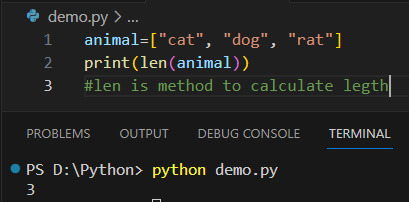
To add elements in array we use append method. For ex.: animal.append("fox")
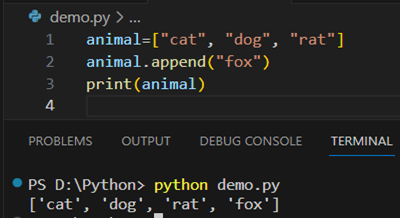
To delete elements in array we use pop method. it deleteindex wise.For Ex:animal.pop(1)
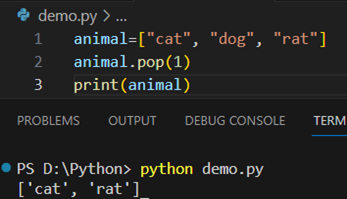
Removes all the elements from the list. Method:- clear()

Returns the number of elements with the specific value. Method: count()
It will return index value of 4 that is 1.
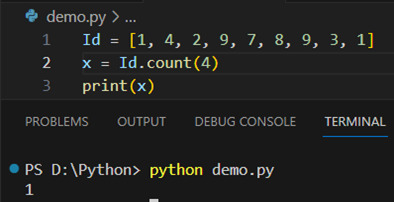
Adds an element at the specified position.Method:- insert()

Removes the first item with the given value. Method: remove()

Reverses the order of the list. Method: reverse()

Sorts the list. Method: sort()

Class:
Class is a blueprint of an object.
It defines the structure and behavior of objects of that class.
The class keyword is used to define a class.
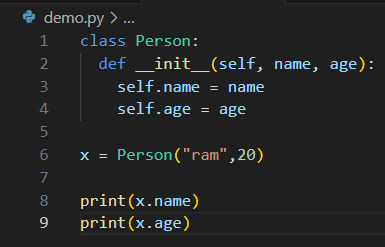
Object:
An object is an instance of a class and a collection of attributes and methods.
For ex.: x = Person("ram", 20)

Inheritance:
Inheritance is a OOP concept that allows you to create a new class based on an existing class. The new class inherits attributes and methods from the existing class, which is referred to as the base or parent class. The newer class is called the derived or child class of the base class.

Polymorphism:
polymorphism means having many forms.
Method Overloading (Compile-Time Polymorphism):
having same name but different parameters.
Method Overriding (Run-Time Polymorphism):
having same name and same parameters.
Encapsulation:
simple lang. wrapping or hiding of data.
object has ability to hide data and behavior that is not necessary to use.
How to take User Input: For ex.
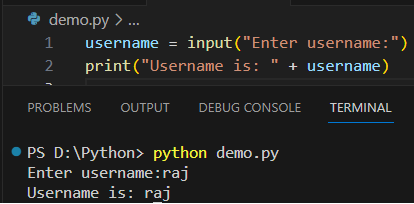
Closing Thought:
Python is a powerful and versatile programming language that has become an integral part of the technology. Everyone is using Python because of its simple syntax, and if you are a beginner, you should definitely go with python.
Credit – Priyanka Divekar
MetricsViews Pvt. Ltd.
MetricsViews specializes in building a solid DevOps strategy with cloud-native including AWS, GCP, Azure, Salesforce, and many more. We excel in microservice adoption, CI/CD, Orchestration, and Provisioning of Infrastructure - with Smart DevOps tools like Terraform, and CloudFormation on the cloud.
www.metricsviews.com.
0 notes
Text
"Python Data Types: Your Path to Enhanced Coding"
Get ready for an exciting journey! We're about to set out on an exploration into the foundational knowledge you need in the world of Python. Python is an incredibly versatile programming language that is used in various industries and can open the door for you to become a skilled coder. Without any more delay, let's start our exploration of the essential concepts that will empower you to excel in Python.
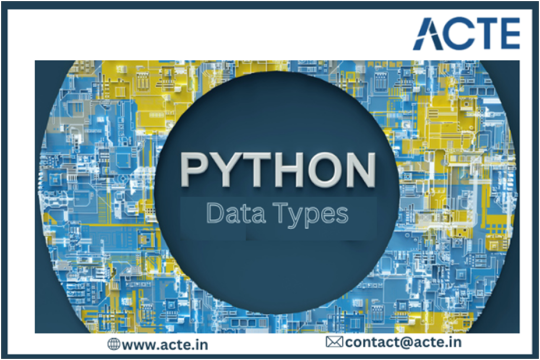
Python data types are the classification or categorization of data items. It represents the kind of value that tells what operations can be performed on a particular data. Since everything is an object in Python Programming, data types are actually classes and variables are instances (object) of these classes. The following are the standard or built-in data types in Python
Numeric
Dictionary
Boolean
Set
Sequence Type
Let’s Explore Deeper Into Each Data Type in Python:
Numeric Data Types:
Numeric data types are used to deal with all types of numerical data packets i.e. integer, float etc.Numeric data types are further divided into 3 types, which are
Integer.
Float.
Complex Number.
Integer in Python:
Integer (int) data type only holds integer numbers, it could be positive or negative.
We can't save decimal numbers in integer data type.
Here's a declaration of a variable x and it is assigned a value a of integer 20:
x = int(20)
Float in Python:
Float data types are used to hold decimal numerical values i.e. 2.13, 3.14 etc.
We can also save whole numbers in float data types.
Here's a declaration of a variable x and it is assigned a value a of float 20.5:
x = float(20.5)
Complex Numbers in Python:
Complex Number data types is used to keep complex numbers in it. Complex numbers are those numerical values which have real & imaginary part.
That's the versatility of python language, I haven't seen complex number data type in any other programming language.
Here's a declaration of a variable x and it is assigned a complex number 1+3j:
x = complex(1+3j)
2. Dictionary (dict):
A dictionary in Python is an unordered collection of data values, used to store data values like a map, unlike other Data Types that hold only a single value as an element, a Dictionary holds a key: value pair.
Key-value is provided in the dictionary to make it more optimized.
Each key-value pair in a Dictionary is separated by a colon : , whereas each key is separated by a ‘comma’.
In Python, a Dictionary can be created by placing a sequence of elements within curly {} braces, separated by ‘comma’.
Values in a dictionary can be of any datatype and can be duplicated, whereas keys can’t be repeated and must be immutable.
The dictionary can also be created by the built-in function dict(). An empty dictionary can be created by just placing it in curly braces{}.
Here's a declaration of a variable x and it's assigned a dictionary data type:
x = dict(name="John", age=36)

3. Boolean (bool):
Data type with one of the two built-in values, True or False.
Boolean objects that are equal to True are truthy (true), and those equal to False are falsy (false). But non-Boolean objects can be evaluated in a Boolean context as well and determined to be true or false.
It is denoted by the class bool.
Here's a declaration of a variable x, assigned a Boolean data type and it's TRUE:
x = bool(1)
4. Set Data Types:
In Python, a Set is an unordered collection of data types that is iterable, mutable and has no duplicate elements.
The order of elements in a set is undefined though it may consist of various elements.
Sets can be created by using the built-in set() function with an iterable object or a sequence by placing the sequence inside curly braces, separated by a ‘comma’.
The type of elements in a set need not be the same, various mixed-up data type values can also be passed to the set.
5. Sequence Data Types:
Sequence Type data types are used to save data in characters form.
We can't save numerical data in sequence type but we can convert the two. ( We will discuss that later )
Sequence Types are further divided into 3 types, which are
String.
List.
Tuple.
String (str):
Strings are used to represent sequences of characters, like words, sentences, or text. They are crucial for text manipulation, string formatting, and working with textual data.
Strings in Python are arrays of bytes representing Unicode characters.
A string is a collection of one or more characters put in a single quote, double-quote, or triple-quote.
In python there is no character data type, a character is a string of length one.
It is represented by str class.
Example:x = "Hello, World"
List (list):
Lists are ordered collections of items.
They can store elements of different data types and are mutable, which means you can add, remove, or modify elements in the list.
Lists are versatile and used for various data storage and manipulation tasks.
Example:x = ["apple", "banana", "cherry"]
Tuple (tuple):
Just like a list, a tuple is also an ordered collection of Python objects.
The only difference between a tuple and a list is that tuples are immutable i.e. tuples cannot be modified after it is created. It is represented by a tuple class.
In Python, tuples are created by placing a sequence of values separated by a ‘comma’ with or without the use of parentheses for grouping the data sequence.
Tuples can contain any number of elements and of any datatype (like strings, integers, lists, etc.).
Having one element in the parentheses is not sufficient, there must be a trailing ‘comma’ to make it a tuple.
Tuples are similar to lists but are immutable, which means you cannot change their content once defined. Tuples are used when you need to ensure that the data remains constant.
Example:
x = ("apple", "banana", "cherry")
These data types are the building blocks of Python programming. As you gain more experience with Python, you'll use these data types extensively to work with a wide range of data and solve various programming problems.
For those looking to expand their Python knowledge, ACTE Technologies is worth exploring. Their instructors are highly skilled and proficient in teaching Python. Whether you prefer online or in-person learning, they offer flexibility in your choice of learning environment. Python program at ACTE Technologies includes certification options and support in finding job placements.
0 notes
Text
How to place a matplotlib plot into an html container using mpld3 and flask
I am trying to use the mpld3-flask example (https://github.com/nipunreddevil/mpld3-flask) as a template to achieve a certain behavior. What I would like, is to add links on the header bar to different plots, rather than having a radio button query form.
Right now, the example code above, in templates/index.html, makes a container and then populates it with a plot when the user submits a query by clicking the "View Plot" button. That happens in this code, as far as I can tell, in index.html:
$("#query").click(function() { $("#loading-div-background").show(); $("#container").hide(); var plot_type = $('input:radio[name=plot_type]:checked').val(); var qu = {"plot_type":plot_type} $.ajax({ type: "POST", async:true, contentType: "application/json; charset=utf-8", url: "/query", data: JSON.stringify(qu), success: function (data) { var graph = $("#container"); graph.html(data); $("#loading-div-background").hide(); $("#container").show(); }, dataType: "html" });});
What I would like instead is to add to the header bar that currently has "Home" in it, and bring up each example plot in a different page. I would route to a different link, and then populate the template html code with the data for the plot, without requiring a user query.
I am a bit of a novice with html and essentially know nothing about JavaScript at this point. My sense here is that there is some relatively easy way to use flask + jinja2 to do this, but I haven't been able to figure it out.
I am having some trouble with the sort of unclear namespaces that result from combining all of these languages. I am usually very strict with namespaces in my own python programming (i.e. I never, ever use 'from ____ import *') so this is driving me a little crazy.
https://codehunter.cc/a/flask/how-to-place-a-matplotlib-plot-into-an-html-container-using-mpld3-and-flask
0 notes
Text
BEST PYTHON TRAINING INSTITUTE IN KOCHI WITH 100% JOB PLACEMENT.
In Kochi, there are numerous institutions offering Python training & courses. Python is a high-level programming language in use today. So , if you're interested in learning Python, I suggest TechnoMaster as the greatest online training facility in Kochi. also you will get 100% Placement Support by our JobsNEAR.in.
Why TechnoMaster?
One of the top training facilities for all IT courses is TechnoMaster. They offer the top Python course training. Since 2001, TechnoMaster has offered online training in Python. Industry professionals instruct the students. The TechnoMaster teachers are very helpful and very qualified. such that the ideas are simple to understand. Instead of theoretical instruction, they offer practical training. They also offer projects that are based on the industry and improve the abilities. The most recent and cutting-edge Python course syllabus is available from TechnoMaster. They offer private live instruction. Top trainers with years of experience will teach you and assist you in reaching your objectives. A training programme, an internship, or a course certificate will be made available to TechnoMaster. Hence, join TechnoMaster to receive the greatest training possible.
You can go to a free trial class to see if you want to enrol in the course.

Pick a job with TechnoMaster while honing your Python skills.The following principal subjects are covered in the courses:
Python introduction Datatypes introduction
Concepts of Programming
Modularity and Functions
Exception Handling and Files for Object-Oriented Programming
GUI Development Using Basic and Advanced Tkinter Widgets
Network and OS Module Programming
Python Advanced Concepts with MongoDB
Please visit the TechnoMaster website for additional information.
#python#pythontraining#online training institutions#kochi#certification#job consultancy#job placement#django#best training institute
0 notes
Text
Price: [price_with_discount]
(as of [price_update_date] - Details)
[ad_1]
Become a Python Programming Expert With Ease!
Python is a simple yet powerful programming language that can enable you to start thinking like a programmer right from the beginning. It is very readable and the stress many beginners face about memorizing arcane syntax typically presented by other programming languages will not affect you at all. Conversely, you will be able to concentrate on learning concepts and paradigms of programming.
This book shall introduce you to an easy way to learn Python in just 7 days and in this time, be able to complete your own projects! By reading the book and implementing what you learn herein, you will realize just why major institutions like NASA, Google, Mozilla, Yahoo, Dropbox, IBM, Facebook and many others prefer to use python in their core products, services and business processes. Let’s begin.
Here what you'll learn after downloading this Python for Beginners book:
✓Introduction
✓Chapter 1: Python: A Comprehensive Background
✓Chapter 2: How to Download and Install Python
✓Chapter 3: Python Glossary
✓Chapter 4: Interacting with Python
✓Chapter 5: Using Turtle for a Simple Drawing
✓Chapter 6: Variables
✓Chapter 7: Loops
✓Chapter 8: Native Python Datatypes
✓Chapter 9: Python Dictionaries
✓Chapter 10: Boolean Logic and Conditional Statements
✓Chapter 11: Constructing ‘While’ Loops In Python
Chapter 12: Constructing ‘For Loops’ In Python Programming
✓Chapter 13: Constructing Classes and Defining Objects
This Book Is Perfect For:
✓- Total beginners with zero programming experience
✓- Returning professionals who haven’t written code in years
✓- Seasoned professionals looking for a fast, simple, crash course in Python
Download your copy today!
ASIN : B075JGW5YK
Language : English
File size : 22184 KB
Text-to-Speech : Enabled
Screen Reader : Supported
Enhanced typesetting : Enabled
X-Ray : Not Enabled
Word Wise : Enabled
Print length : 137 pages
[ad_2]
0 notes
Text
Bottom-up approach to crack your python interview
Key Features
Get the answer for the most common and challenging Python question
Learn to trace the code and answer the question correctly
Explore the solutions of GUI and DBMS in Python
Gain sufficient understanding on Machine Learning library and Pandas
Description
This book covers all possible interview questions and coding in Python. It presents written theory as well as practical questions as all the interviewers do not follow the same pattern. Questions are jumbled and compiled.
Practical questions may help you to understand the logic and will help you to fight the technical round. Simple questions with deep coding are the hallmark of this book.
With over 242 questions in this book, you will be able to crack your Python interview. The book covers the following topics:
Variable, Datatype, type conversion, Operators, if-else, loops ,List , Tuples, Set ,Dictionary, Functions, Array, classes and objects, constructor , Inheritance, Encapsulation, keywords , regular expression, Random Module, Sys Module , OS Module , Statistics Module, widgets of Tkinter , Multithreading, other GUI Framework , work on multiple Tkinter windows , File Input-output , file handling with GUI, MySQL , SQLite , MongoDB , Redis, connectivity with GUI, Matplotlib Library, Django, Flask.
What you will learn
Become a Python Developer without having to spend a lot of money on theoretical content.
You will achieve the confidence to tackle the most challenging questions on Python.
You will develop a strong understanding around the entire ecosystem of Python programming.
Who this book is for
This book is targeted at Python Developers, Technical specialist, Beginners who want to stand out in a Python coding interview.
Table of Contents
1. Core Concept
2. OOPs Concept
3. Python Module
4. Python GUI
5. File Handling
6. Python Database
7. NumPy, Pandas
8. Django, Flask
0 notes
Text
Javascript convert string to date

JAVASCRIPT CONVERT STRING TO DATE HOW TO
JAVASCRIPT CONVERT STRING TO DATE CODE
Template literals (Template Strings) are string literals that allow us to embed expressions. Use the Template Literals to Convert an Integer to a String in JavaScript The typeof() function here tells the datatype of the variable in JavaScript. On adding a string, the number gets automatically converted to a string.
JAVASCRIPT CONVERT STRING TO DATE CODE
This is one of the fastest methods to convert a number to a string.Ĭalculator In JavaScript Source Code freeload | 2020 JavaScript Projects With Source Code string In this method, we add '' before or after the number to convert it to a string. Single quotes and double quotes are used to represent a string in programming. Use '' to Convert an Integer to a String in JavaScript
JAVASCRIPT CONVERT STRING TO DATE HOW TO
In this tutorial, different methods are discussed on how to a number to a string in JavaScript. Integers represent numbers, and the string data type defines the textual data. Numbers and strings are primitive datatypes in Python. Use the toString() Function to Convert an Integer to a String in JavaScript.Use the String() Function to Convert an Integer to a String in JavaScript.Use the Template Literals to Convert an Integer to a String in JavaScript.Use '' to Convert an Integer to a String in JavaScript.For better understandability, different examples are also provided. This post briefly demonstrates the purpose and working of the date.toString() method in JavaScript. The date.toString() method does not accept any arguments and just converts the provided date/time to a string. The Date toString() method is applied on the date object. In JavaScript, the date.toString() method is utilized to display the date and time in a string format. In the output, the value presented in the date object is converted into string and is printed on the browser. In our case, we have used 3 (as the month value) which refers to the April month. Note: While using the date.toString() method, the 0 refers to the January and 11 represents the December month. In the end, using the document.writeln() method is utilized to display the string format in the browser. After that, the toString() method is utilized to transform the numerical information into the string format. These values are saved in the date object. In this example, numerical values are passed to the built-in Date() method. Example 2: Using the Date toString ( ) method This method converts the information into the string format. Example 2: To Convert the User Defined Date to StringĪnother example is given here by employing the toString() method. Upon pressing the button, the current date, day, and time is displayed on the browser. The outcome of the above code is presented here. In the end, the string is assigned to the HTML element (whose id=test) for display in the browser.After that, the toString() method is applied on the object named date and the result is stored in a string variable.The Date() method contains the current date/time. In the myFunction(), an object of the Date() is created.A function named myFunction() is created that will be called on the onclick event of the button.The description of the above code is provided here: ĭocument.getElementById ( "test" ).innerHTML = string Press button to display the date and time as a string. Example 1: Using the Date toString ( ) method

0 notes
Text
Data Types of JavaScript

JavaScript is a scripting language which is light weight and cross-platform. Javatpoint provides Best online training with live projects, full -time job assistance, interview preparations and many more. Learn Java/ Python/ Web designing/ Networking and much more from Best Institute in Noida.
Address: G-13, 2nd Floor, Sec-3 Noida, UP, 201301, India
Email: [email protected]
Contact: (+91) 9599321147, (+91) 9990449935
#javascript#datatypes#database#developer#python#pythontraining#programmer#oops#coding#programming#tutorial#awstraining#meanstacktraining#webdesigningtraining#networkingtraining#digitalmarketingtraining#devopstraining#javatraining#traininginstitute#besttraininginstitute#education#online#onlinetraining#training#javatpoint#traininginnoida#trainingspecialization#certification#noida#trainingprogram
2 notes
·
View notes